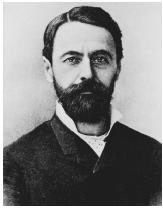Joseph-Achille Le Bel

FRENCH CHEMIST
1847–1930
Joseph-Achille Le Bel, born in Pechelbronn, France, was, with Dutch physical chemist Jacobus Hendricus van't Hoff, the cofounder of modern stereochemistry. They independently established the relation between optical activity and asymmetric carbon compounds.
Le Bel was born into a wealthy family that controlled the petroleum industry in Pechelbronn, Alsace. In 1865 he was sent to the École Polytechnique in Paris to obtain a chemical education and spent most of his time there doing chemical research. After graduation, he worked with the French chemists Antoine Balard and Adolphe Wurtz in Paris, in between intermediate periods of refinery construction at home. Finally in 1889, he sold his shares in the family business and established a private laboratory in Paris where he devoted himself to organic chemistry and, in his later years, paleontology, botany, and philosophy. An independent thinker who never held an academic appointment, Le Bel did manage to achieve general recognition as a chemist and even became president of the French Chemical Society in 1892.
In 1874, at the age of twenty seven, Le Bel presented a brief paper to the Paris Chemical Society that led to his scientific fame, although it may be regarded as his only outstanding contribution to the field of chemistry. By the late 1840s the great chemist and microbiologist Louis Pasteur had separated two sorts of tartrate crystals of the same composition, each crystal shape being the mirror image of the other. These crystals in solution not only rotated the plane of polarized light to a certain angle (optical activity), the rotation also occurred in opposite directions. Pasteur called such pairs of substances optical isomers , and because they showed no difference in chemical properties, they were represented by the same constitutional structural formula in the new chemical structure theory. Le Bel then extended the structure theory, from constitutional structural to configurational representations in three-dimensional space, to account for the difference in optical isomers. He argued that if a tetravalent carbon atom combined with four different groups, as in tartrate, the carbon must be asymmetric in three-dimensional space (i.e., without a symmetry plane or center). Furthermore, for each such asymmetric carbon there were exactly two different structures (stereoisomers), each being the mirror image of the other, just like the crystal shapes of Pasteur. Le Bel's structure theory could not explain optical activity, but it explained and predicted which compounds had stereo-isomers and which did not, an approach that he also extended to nitrogen compounds.
Oddly enough, van't Hoff, with whom Le Bel had worked in Wurtz's laboratory shortly beforehand, independently arrived at the same theory from a different starting point at virtually the same time.
SEE ALSO Chirality ; Pasteur, Louis ; VAN'T Hoff, Jacobus .
Joachim Schummer
Bibliography
Leicester, Henry M. (1973). "Le Bel, Joseph Achille." In Dictionary of Scientific Biography, Vol. VIII, ed. Charles C. Gillispie. New York: Scribners.
Comment about this article, ask questions, or add new information about this topic: